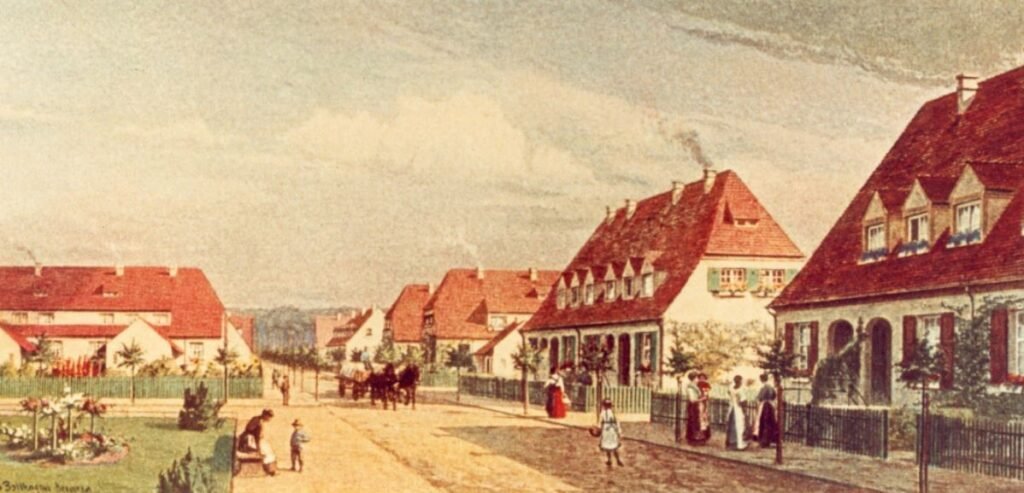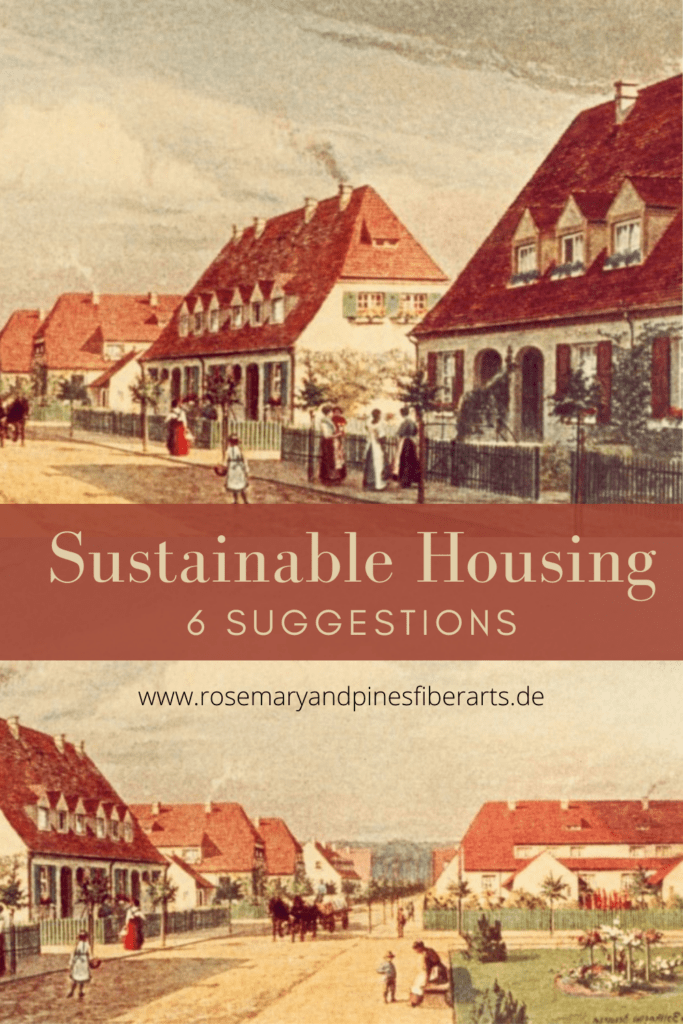In a recent newsletter, I shared some information about the renovation of our 110 year old home. Afterwards, several people reached out to me and were interested in learning more about our approach towards sustainable housing and renovation.
Sustainability is a key value for me. Not only in my natural dyeing and handmade wardrobe endeavors, but it shines through every aspect of my life. And housing is of course no exception. It is my objective to share our approach to provide some food for thought and ideas if you are in a similar stage in your life.
Since the majority of my readership appears to be located in the U.S., please note that I wrote this article from a German point of view. Not all of the aspects below may apply to your situation in the same way. However, I think it will still be of interest to you. I oftentimes find it valuable to consider a different perspective which might just not be common in one’s region but could be implemented nonetheless.
#1 Existing Property vs. New Build
This is for sure a controversial topic. You could argue that you can build a new home much more energy efficient and thus more sustainable than an old house. For us, purchasing an old home and updating it to current standards was more appealing. Not only does it feel great to “reuse” an already existing house, we didn’t need nearly as much building materials as if we would have decided to build a home from scratch. Another great factor in this decision was the fact that old homes naturally come with tons of character which is a lot harder (but certainly not impossible) to create in a new build.

#2 Buy Small
When we were looking for a house, we visited a variety of houses. Some were larger and some were smaller. In the end, we decided that we wanted to claim as little housing space as possible and decided to purchase the smallest house we had toured. I was confident that I would be able to design the spaces in such a way that we would feel comfortable and have everything we need.
Benefits of Owning a Small House
Buying a small house has many benefits. Not only is it less expensive compared to the purchasing costs of a bigger house in the same area, it also requires less energy for heating (and cooling, if applicable). The renovation and materials costs are generally lower because there is simply not as much flooring space, wall surface etc. Another great benefit is the fact that you cannot fit as much stuff in a small house.
Let’s be honest, in today’s world, most of us own way too many things. And although I consider myself a minimalist, I was shocked how much we owned when I had to go through everything and prepare for the move. Luckily, I started this process very early and was able to go through literally every item we owned and declutter a lot. In the same vein, living in a small home also comes with the benefit of limited space to fill with additional purchases.
Overall, we are very happy with the decision of moving to a smaller home. We had people telling us beforehand that they considered our house too small for a family of four. But whenever they see how it looks inside after the renovation, the uniform feedback we get is that “it looks so much bigger than it actually is.”

#3 Energy Efficiency
One topic that was important to us when renovating our house was to update the existing structures to be more energy efficient and thus more sustainable. We hired this part almost completely out and I am certainly not an expert but I will tell you briefly what we did. We insulated the walls, roof and basement floors. In addition, we replaced the front and back door and some of the windows to reduce drafts. On the roof, we installed solar thermal trays for harnessing solar energy to generate thermal energy (meaning the energy of the sunlight is used for water heating). We installed a water-bearing wood stove which also heats the water in the house and heating system. And we are about to add aerators to the faucets and shower heads to reduce water usage.
#4 Buy Used and Look for Timeless Pieces
When designing the rooms, it was my goal to honor the time period when the house was built (1913). I did a lot of research and tried to find pieces that would fit the age and feel of the house. This meant that I was looking for old pieces which obviously had to be purchased used instead of new.
There are numerous benefits of buying used instead of new. You save an item from being sent to the landfill. At the same time, no new item needs to be manufactured using precious resources and energy. The quality of older furniture generally tends to be higher. At the same time, the price of a used item is usually lower compared to buying new. And you don’t have to change everything up in just a couple of years because your trendy furnishings just aren’t in style anymore.
Even better than buying used is the possibility to receive items for free. Family, friends and neighbors are often happy to pass something on to you that they weren’t using anymore anyway.
You will have to be somewhat flexible with what you bring into your home, though. Usually, you will not be able to find a piece that is exactly the same size, shape and color you imagined in your head. But at the same time, this will allow for finding unique items you might have not even thought of. Your house will definitely not look like everybody else’s and this, at least in my opinion, is a good thing.
#5 Donate or Sell What You Don’t Need
This is true whether you live in a big or small house, whether you are a renter or owner. Ridding yourself of the excess is a great feeling. Not only do you keep your home from being cluttered. It is also sustainable to pass on anything you don’t want anymore to someone else. You would be surprised how many things you own that you don’t use anyway and therefore can sell. But even if you won’t be able to sell an item, you can always donate it or give it away for free. When we decluttered our home, there were actually only a handful of things that had to be thrown away because they just weren’t usable anymore. And we sold and donated all the rest.
Unfortunately, decluttering isn’t something that you only do once and won’t have to revisit ever again. It is more of a continuous effort. But from my experience, once you get in the habit of it, it will just become a simple regular task.
#6 Sustainable Renovation with Natural Materials
Nowadays, you have different options to choose from for basically anything. Whether it is a yoghurt at the supermarket or building materials for your renovation.
Selecting sustainable materials comes with multiple benefits. Not only is it beneficial for the environment but often also for your health. Off the top of my head, these examples come to mind when I think about sustainable renovation choices we made.
Front and Back Door
When we replaced our front and back door, we chose wooden doors instead of plastic. In addition, we went for larch wood instead of the more popular shorea. Shorea is a genus of rainforest trees. The timber is sold under the names lauan, luan, lawaan, meranti, seraya, balau and bangkirai. Definitely not local to us. Larch trees, on the other hand, can be found all over Europe.
Walls
For the treatment of the walls, we decided to go with lime plaster. It is a traditional and natural material made from sand, water and lime. It is breathable, antifungal and improves air quality.
Wood Treatment
When we bought our house, all of the doors, the staircase as well as the built-in closet were painted. And since the house is over 100 years old, it wasn’t just one single layer of paint. There were layers upon layers upon layers of paint, some of them in rather questionable color choices. In a very time consuming and challenging process, I stripped off all of it.
When it came to the decision about the further treatment of the raw wood, we opted for linseed oil and linseed oil paint. Linseed oil has been used for hundreds of years to treat and protect wooden surfaces. It is a natural, non-toxic material made from flaxseeds. You can use it in its natural form to enhance the wood grain and luster. Or you can use it in the form of linseed oil paint in the colorways of your choice. Granted, it takes a bit longer to dry. You also need to work thoroughly and apply pressure to the paint brush. But the results are so worth it!
If you want to read more about our home, there is a previous blog post where I talk about five benefits of living in an old house. You can find it here.
Do you have any questions about our approach towards sustainable housing? Or would you like to share some of your sustainable renovation ideas? Let us know in the comments below!
Pin It For Later: Our Apporach Towards Sustainable Housing

Did you find this blog post valuable or helpful? If so, you can support my website by buying me a coffee below, purchasing my knitting patterns or yarns or simply by leaving a comment. Thank you!




